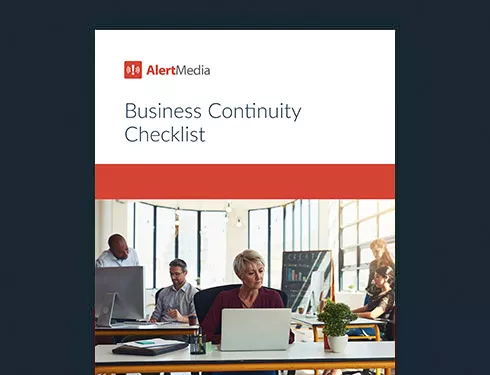
Company Resilience: Prepare for the Unforeseen [+ Business Continuity Checklist]
Preparing for specific threats is one thing, but creating a holistically resilient company is something entirely different. Learn how to protect your company from all sides in this post.

As a business leader, you protect your company’s assets, operations, and people from threats every day. You run safety drills for emergencies, develop business continuity plans, and work hard to reduce foreseeable risks.

Unfortunately, you can’t have a comprehensive plan for every hazard your company faces. Whether it’s a once-in-a-generation flood, a pandemic, or a plane engine falling through your roof, there are some events you can neither predict nor plan for. However, your company needs to be ready to respond rapidly and effectively.
That’s where company resilience comes in. A resilient organization will be well-prepared with tools, systems, and leadership to weather any storm and keep the company running.
In this article, we’ll explore what makes an organization resilient, the threats you might face, and how to build resilience into your company culture.
What Is Company Resilience?
Company resilience is an organization’s ability to deal with change, unforeseen events, and emergencies while minimizing the impact on operations and personnel. In some cases, it means making minor operational changes to deal with a vulnerability. Under more extreme circumstances, such as a hurricane or winter storm, it could mean temporarily shutting down but being prepared to resume business as quickly and smoothly as possible.
Download Our Business Continuity Checklist
Take The Leukemia & Lymphoma Society as an example. Their workforce of 1,000 employees and 5,000 volunteers is dispersed across over 25 regions, and many people are now in remote and hybrid work settings. They have response plans in place for emergencies like hurricanes and winter storms. But the decentralized nature of their team means they could be facing multiple emergencies simultaneously, each with varying conditions.
Thanks to a proactive approach to company resilience, including threat intelligence and communications tools, they’re prepared to handle challenges of nearly any shape and size.
While company resilience is an overarching theme, there are several related concepts that play an essential part in an organization’s ability to adapt:
- Business continuity: Business continuity is the ability to maintain normal business functions through a potential disruption. For example, a shipping company needs to consider business continuity plans during a winter storm that makes driving or flying dangerous.
- Operational resilience: Operational resilience is similar to business continuity in that it centers on a company’s operations. However, it reflects the ability to adapt to unforeseen circumstances rather than predictable disruptions.
- Financial resilience: Most companies have cash flow projections built on invoicing and revenue cycles, payment terms, and expected revenues. Financially resilient businesses can survive a shock to normal business operations, whether it’s a single client not paying their bill or a general economic downturn.
- Technological resilience: With increased automation comes increased reliance on technology, and losing access to a given service or function can be crippling. Technological resilience deals with outage preparedness and can include anything from offsite backups to redundant telecom services and geographically dispersed data centers.
- Cultural resilience: Operations, finances, and technology are all important. But a company is nothing without its people. A company that’s culturally resilient has an engaged workforce that will band together and trust each other to steer the business through a crisis.
Threats to Your Business Resilience and Continuity
Businesses face a variety of risks every day—many of them minor. But as the size of risk grows, so does its potential impact on your business. Some of the most common threats will test a company’s resilience.
Natural disasters
Wherever your company does business, you may face the risk of a natural disaster. Some regions deal with earthquakes, others with tornadoes or hurricanes, and nearly every part of the U.S. experiences severe winter weather. And scientific research indicates that climate change could lead to a 60% increase in extreme storms over the next century.
Some natural disasters, such as earthquakes, strike without warning. For others, like hurricanes or winter storms, you could have hours or days of advance notice. But even then, the situation can change in an instant. Natural disasters can disrupt or halt business operations while, at the same time, putting your employees at risk.
Utility and telecom outages
Electricity, internet, and phone outages are not new phenomena. Storms knock down power lines, parts break, and mistakes happen, leading to frustrating but usually short service disruptions.
But even a brief outage can impact business. Given the rise in targeted attacks on power grids, the issue should be at the forefront of contingency planning. For most companies, power and internet access are foundational to normal operations, and it’s critical to deal with outages—especially prolonged ones due to sabotage—for business resilience.
Cyberattacks
Industry research shows over 310 million accounts were leaked or stolen online in 2022. Surprisingly, that’s an improvement over 2021, but data breaches are still a painfully familiar business risk. And many companies don’t have a robust disaster recovery plan.
In the context of company resilience, cybersecurity threats impact businesses in a number of ways:
- The potential loss of confidential data
- Erosion of customer trust
- Susceptibility to similar breaches in the future
- High cost of crisis cleanup and adoption of security controls

Supply-chain disruptions
The early days of the COVID-19 crisis exposed the fragility of just-in-time inventory management systems. As supply-chain disruptions cascaded from manufacturers to wholesalers to retailers, various everyday items became nearly unobtainable for weeks on end.
While the coronavirus pandemic was at the extreme end of the spectrum, hiccups in supply chains are a common occurrence. Most companies can survive a brief shipment delay every once in a while. But if a critical component becomes unavailable for several months, does your company have a resilient supply chain to find a workaround and keep business moving?
Security incidents
Security incidents are often the most challenging risk to predict and one of the greatest threats to your employees’ safety. In the event of arson, a break-in, or an active shooter, your team may have mere minutes—or even seconds—to react.
Such traumatic events could have long-lasting effects on your company—but planning, preparation, and training can mitigate the impact. Start by setting clear expectations for how employees should handle potential threats, providing guidelines on when to contact emergency services, and ensuring that your team has ways to evacuate safely should the need arise.
How to Plan for Resilience
It would be impossible for a company to predict and plan for every risk it faces. Even if you consider only the most likely scenarios, there’s not enough time to deal with every eventuality.
Instead, you can build business resilience. A resilient company has the resources to face a variety of threats and adapt to rapidly changing conditions. There are four critical steps to building strong company resilience.
1. Perform a risk assessment
The first step is to understand the risks your company might face. During the threat assessment process, you’ll review any number of risks and evaluate them according to two main criteria:
- Likelihood: What are the chances of a given event happening? For example, a company in Buffalo, NY, faces a high likelihood of severe winter storms. Conversely, a business in Los Angeles, CA, has a very low chance of dealing with a hurricane.
- Potential impact: How severe would the consequences be if the threat materializes? For example, a tornado directly striking your facility would have a high potential impact. But a winter storm that shuts a restaurant down for a weekend would be relatively low impact.
You can decide which risks need the most attention based on those two criteria. You would want to draw up very specific plans for anything with both high likelihood and high impact. But lower risks would fall under your general business resilience processes since the stakes wouldn’t justify the cost of developing a separate response plan.
2. Develop crisis management plans
You may be unable to predict the specific risks your company will face. But with processes and procedures in place, you’ll be better positioned to deal rapidly with many threats.
It’s critical to build crisis management strategies with your company’s particular ecosystem in mind. Consider the following questions as you develop procedures:
- Who should have decision-making authority in the event of an emergency?
- Do you have a backup decision-maker ready to step in?
- How will you collect and disseminate information to aid the crisis response plan?
- Who are the key stakeholders to consult for any given crisis?
- Once the emergency is over, how will you evaluate successes and setbacks and use them to refine your plans for future crises?
3. Leverage communication tools and strategies
Effective communication is critical to a swift and effective response when a crisis strikes. Resilient companies can use mass notification systems to keep employees updated on events as they happen in real-time. At the same time, employees can use the two-way communication feature to send status updates or calls for assistance.
Include communications drills in your emergency preparedness training to ensure any notification templates are effective, all employees are receiving messages, and they know how to respond. Your safety leaders can also practice using the platforms to get familiar with the tools they’ll need to operate in an emergency.
4. Prioritize company-wide resilience engagement
During an emergency, the last thing you want is people panicking or taking matters into their own hands. Your company’s success in responding to a threat depends on your team’s ability to follow the procedures you’ve developed and trained them on.
One of the best ways to build engagement is to practice ongoing resilience management. Integrating your resilience efforts under one umbrella ensures the whole company is on the same page and working towards the same goals.
There are a few keys to resilience management:
- Secure buy-in from every level of the company—employees are more apt to trust the process if they see executives actively engaged in the effort
- Keep thorough documentation and track key metrics that indicate progress
- Weave organizational resilience into your company culture so that it becomes an ingrained part of the business rather than an afterthought
Improving Risk Management Through Resilience
Anyone, especially business leaders, would agree that the scariest risks are the ones they can’t foresee. As rare as they may (hopefully) be, facing an emergency that you haven’t planned and practiced for could threaten your entire business model—not to mention the well-being of your employees.
You might not be able to eliminate those risks. But by building a culture of company resilience, you can ensure your team is as prepared as possible to face a wide range of threats, adapt to changing conditions, survive, and ultimately thrive.




